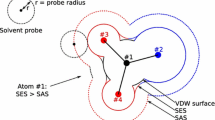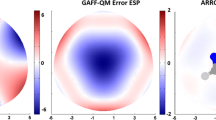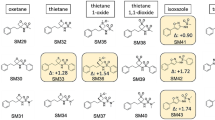Abstract
The performance of the extended solvent-contact model has been addressed in the SAMPL5 blind prediction challenge for distribution coefficient (LogD) of drug-like molecules with respect to the cyclohexane/water partitioning system. All the atomic parameters defined for 41 atom types in the solvation free energy function were optimized by operating a standard genetic algorithm with respect to water and cyclohexane solvents. In the parameterizations for cyclohexane, the experimental solvation free energy (ΔG sol ) data of 15 molecules for 1-octanol were combined with those of 77 molecules for cyclohexane to construct a training set because ΔG sol values of the former were unavailable for cyclohexane in publicly accessible databases. Using this hybrid training set, we established the LogD prediction model with the correlation coefficient (R), average error (AE), and root mean square error (RMSE) of 0.55, 1.53, and 3.03, respectively, for the comparison of experimental and computational results for 53 SAMPL5 molecules. The modest accuracy in LogD prediction could be attributed to the incomplete optimization of atomic solvation parameters for cyclohexane. With respect to 31 SAMPL5 molecules containing the atom types for which experimental reference data for ΔG sol were available for both water and cyclohexane, the accuracy in LogD prediction increased remarkably with the R, AE, and RMSE values of 0.82, 0.89, and 1.60, respectively. This significant enhancement in performance stemmed from the better optimization of atomic solvation parameters by limiting the element of training set to the molecules with experimental ΔG sol data for cyclohexane. Due to the simplicity in model building and to low computational cost for parameterizations, the extended solvent-contact model is anticipated to serve as a valuable computational tool for LogD prediction upon the enrichment of experimental ΔG sol data for organic solvents.






Similar content being viewed by others
References
Lipinski CA, Lombardo F, Dominy BW, Feeney PJ (1997) Experimental and computational approaches to estimate solubility and permeability in drug discovery and development settings. Adv Drug Deliv Rev 23:3–25
Hermens JLM, de Gruijin JHM, Brooke DN (2013) The octanol–water partition coefficient: strengths and limitations. Environ Toxicol Chem 32:732–733
van de Waterbeemd H, Camenisch G, Folkers G, Chretien JR, Raevsky OA (1998) Estimation of blood-brain barrier crossing of drugs using molecular size and shape, and H-bonding descriptors. J Drug Target 6:151–165
van de Waterbeemd H, Gifford E (2003) ADMET in silico modelling: towards prediction paradise? Nat Rev Drug Discov 2:192–204
Dearden JC (2007) In silico prediction of ADMET properties: how far have we come? Expert Opin Drug Metab Toxicol 3:635–639
Kenny JR (2013) Predictive DMPK: in silico ADME predictions in drug discovery. Mol Pharm 10:1151–1152
Smith DA (2013) Evolution of ADME science: where else can modeling and simulation contribute? Mol Pharm 10:1162–1170
Roda A, Minutello A, Angellotti MA, Fini A (1990) Bile acid structure-activity relationship: evaluation of bile acid lipophilicity using 1-octanol/water partition coefficient and reverse phase HPLC. J Lipid Res 31:1433–1443
Leung SSF, Sindhikara D, Jacobson MP (2016) Simple predictive models of passive membrane permeability incorporating size-dependent membrane-water partition. J Chem Inf Model 56:924–929
Jing P, Rodgers PJ, Amemiya S (2009) High lipophilicity of perfluoroalkyl carboxylate and sulfonate: implications for their membrane permeability. J Am Chem Soc 131:2290–2296
Schneider N, Lange G, Hindle S, Klein R, Rarey MA (2013) A consistent description of hydrogen bond and dehydration energies in protein-ligand complexes: methods behind the HYDE scoring function. J Comput Aided Mol Des 27:15–29
Ghose AK, Crippen GM (1987) Atomic physicochemical parameters for three-dimensional-structuredirected quantitative structure-activity relationships. 2. Modeling dispersive and hydrophobic interactions. J Chem Inf Comput Sci 27:21–35
Rekker RF, Kort HMD (1979) Hydrophobic fragmental constant—extension to a 1000 data point set. Eur J Med Chem 14:479–488
Yaffe D, Cohen Y, Espinosa G, Arenas A, Giralt F (2002) Fuzzy ARTMAP and back-propagation neural networks based quantitative structure-property relationships (QSPRs) for octanol-water partition coefficient of organic compounds. J Chem Inf Comput Sci 42:162–183
Hou TJ, Xu XJ (2003) ADME evaluation in drug discovery. 2. Prediction of partition coefficient by atom-additive approach based on atom-weighted solvent accessible surface areas. J Chem Inf Comput Sci 43:1058–1067
Wegner JK, Zell A (2003) Prediction of aqueous solubility and partition coefficient optimized by a genetic algorithm based descriptor selection method. J Chem Inf Comput Sci 43:1077–1084
Souza ES, Zaramello L, Kuhnen CA, Junkes BS, Yunes RA, Heinzen VEF (2011) Estimating the octanol/water partition coefficient for aliphatic organic compounds using semi-empirical electrotopological index. Int J Mol Sci 12:7250–7264
Toropov AA, Toropova AP, Raska I, Benfenati E (2010) QSPR modeling of octanol/water partition coefficient of antineoplastic agents by balance of correlations. Eur J Med Chem 45:1639–1647
Daina A, Michielin O, Zoete V (2014) iLOGP: a simple, robust, and efficient description of n-octanol/water partition coefficient for drug design using the GB/SA approach. J Chem Inf Model 54:3284–3301
Kim T, Park H (2015) Computational prediction of octanol–water partition coefficient based on the extended solvent-contact model. J Mol Graph Model 60:108–117
Huang W, Blinov N, Kovalenko A (2015) Octanol−water partition coefficient from 3D-RISM-KH molecular theory of solvation with partial molar volume correction. J Phys Chem B 119:5588–5597
Banks WA, Kastin A (1985) Peptides and the blood-brain barrier: lipophilicity as a predictor of permeability. Brain Res Bull 15:287–292
Kellogg GE, Burnett JC, Abraham DJ (2001) Very empirical treatment of solvation and entropy: a force field derived from LogPo/w. J Comput-Aided Mol Des 15:381–393
Delaney JS (2005) Predicting aqueous solubility from structure. Drug Discov Today 10:289–295
Mayer PT, Anderson BD (2002) Transport across 1, 9-decadiene precisely mimics the chemical selectivity of the barrier domain in egg lecithin bilayers. J Pharm Sci 91:640–646
Toulmin A, Wood JM, Kenny PW (2008) Toward prediction of alkane/water partition coefficients. J Med Chem 51:3720–3730
Young RJ, Green DVS, Luscombe CN, Hill AP (2011) Getting physical in drug discovery II: the impact of chromatographic hydrophobicity measurements and aromaticity. Drug Discov Today 16:822–830
Abraham MH, Chadha HS, Whiting GS, Mitchell RC (1994) Hydrogen bonding. 32. An analysis of water-octanol and water-alkane partitioning and the & ∆log P parameter of Seiler. J Pharm Sci 83:1085–1100
Saunders RA, Platts JA (2004) Scaled polar surface area descriptors: development and application to three sets of partition coefficients. New J Chem 28:166–172
Zerara M, Brickmann J, Kretschmer R, Exner TE (2008) Parameterization of an empirical model for the prediction of n-octanol, alkane and cyclohexane/water as well as brain/blood partition coefficients. J Comput-Aided Mol Des 23:105–111
Kenny PW, Montanari CA, Prokopczyk IM (2013) ClogPalk: a method for predicting alkane/water partition coefficient. J Comput Aided Mol Des 27:389–402
Lamarche O, Platts JA, Hersey A (2004) Theoretical prediction of partition coefficients via molecular electrostatic and electronic properties. J Chem Inf Comput Sci 44:848–855
Caron G, Ermondi G (2005) Calculating virtual log P in the alkane/water system logPalk N and its derived parameters ∆log Poct_alk N and log Dalk pH. J Med Chem 48:3269–3279
Leung SSF, Sindhikara D, Jacobson MP (2016) Simple predictive models of passive membrane permeability incorporating size-dependent membrane-water partition. J Chem Inf Model 56:924–929
Park H (2014) Extended solvent-contact model approach to SAMPL4 blind prediction challenge for hydration free energies. J Comput-Aided Mol Des 28:175–186
Chung KC, Park H (2015) Accuracy enhancement in the estimation of molecular hydration free energies by implementing the intramolecular hydrogen bond effects. J Cheminform 7:57
Mączyński A, Wiśniewska-Gocłowska B, Góral M (2004) Recommended liquid–liquid equilibrium data. Part 1. Binary alkane–water systems. J Phys Chem Ref Data 33:549–577
Escher BI, Schwarzenbach RP, Westall JC (2000) Evaluation of liposome−water partitioning of organic acids and bases. 1. Development of a sorption model. Environ Sci Technol 34:3954–3961
Marenich AV, Kelly CP, Thompson JD, Hawkins GD, Chambers CC, Giesen DJ, Winget P, Cramer CJ, Truhlar DG (2012) Minnesota solvation database—version 2012. University of Minnesota, Minneapolis
Wang J, Wang W, Huo S, Lee M, Kollman PA (2001) Solvation model based on weighted solvent accessible surface area. J Phys Chem B 105:5055–5067
Lee S, Cho KH, Lee CJ, Kim GE, Na CH, In Y, No KT (2011) Calculation of the solvation free energy of neutral and ionic molecules in diverse solvents. J Chem Inf Model 51:105–114
Choi H, Kang H, Park H (2015) Computational prediction of molecular hydration entropy with hybrid scaled particle theory and free-energy perturbation method. J Chem Theory Comput 11:4933–4942
Acknowledgments
This research was supported by Creative Materials Discovery Program through the National Research Foundation of Korea funded by the Ministry of Science, ICT and Future Planning (2015M3D1A1069705), and by Basic Science Research Program through the National Research Foundation of Korea funded by the Ministry of Education (NRF-2016R1D1A1B01014187).
Author information
Authors and Affiliations
Corresponding author
Electronic supplementary material
Below is the link to the electronic supplementary material.
Rights and permissions
About this article
Cite this article
Chung, KC., Park, H. Extended solvent-contact model approach to blind SAMPL5 prediction challenge for the distribution coefficients of drug-like molecules. J Comput Aided Mol Des 30, 1019–1033 (2016). https://doi.org/10.1007/s10822-016-9928-x
Received:
Accepted:
Published:
Issue Date:
DOI: https://doi.org/10.1007/s10822-016-9928-x




